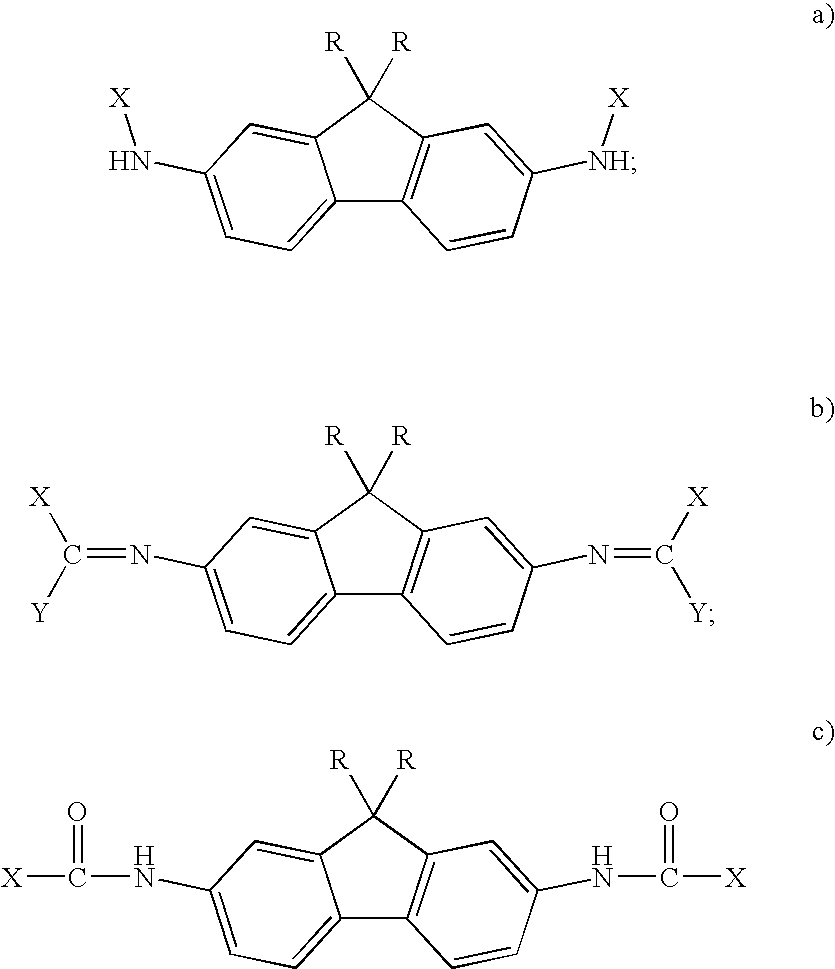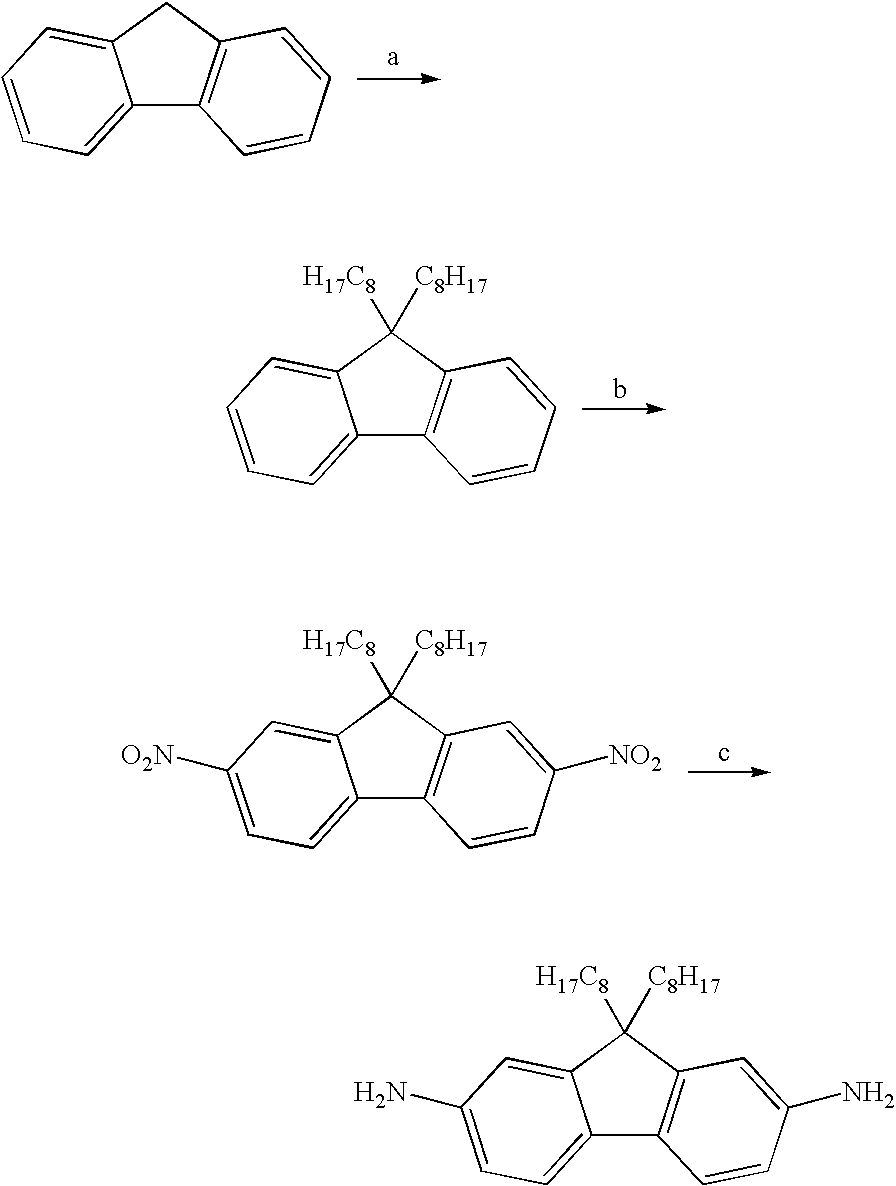Novel Aromatic/Aliphatic Diamine Derivatives For Advanced Compositions And Polymers
a technology of aromatic/aliphatic diamine and derivatives, applied in the field of novel compositions derived from 9, 9dialkyl fluorene diamine, can solve the problems of insolubility of fluorene diamine, danger to living systems and electronics, and the use of alkyl side chains on fluorene diamine has never been demonstrated
- Summary
- Abstract
- Description
- Claims
- Application Information
AI Technical Summary
Benefits of technology
Problems solved by technology
Method used
Image
Examples
example 1
Structural / Radiation Shielding Epoxies
[0025] AFDA was prepared by first alkylating fluorene followed by nitration. The molecule was then reduced to the diamine and used in epoxy formulation. This synthesis was illustrated above. To formulate the epoxy resin, the diamine was slowly added to tetraglycidylmethylenedianiline (TGMDA) while heating to 60° C. in a stainless steel mold. The sample was subsequently heated to 80° C. under vacuum and finally placed in a conventional oven and heated to 100° C. for 14 hrs., 120° C. for 1 hr., 140° C. for 1 hr., and 177° C. for 1 hr. The result was a 10.16 cm×10.16 cm epoxy plaque.
[0026] Computational modeling of the resin formulation was performed to determine the radiation shielding characteristics of the material. Calculations of dose, dose equivalent, and other possible metrics were made at various depths of the material using realistic galactic cosmic ray radiation environments and the NASA Langley radiation transport code HZETRN. This cod...
example 2
Monomer Synthesis
[0036]
(a) Pd[P(t-Bu)3]2, KOH / H2O, cetyltrimethyl-ammonium bromide, 1,4-bromonitrobenzene
[0037] Into a 100 mL Schlenk flask was placed 103.9 mg, 0.29 mmol of cetyltrimethylammonium bromide and 293.0 mg, 0.57 mmol of Bis(tri-t-butylphosphine)palladium(0) under an Argon atmosphere. AFDA (12.00 g, 57.1 mmol) and 1,4-bromonitrobenzene (11.64 g, 57.6 mmol) were added with toluene (bubbled with nitrogen) and stirred until they completely dissolved. 10.65 g of a 45 wt % KOH solution in water (85.6 mmol) was added and the vessel was heated to 90° C. for 24 hr. Upon cooling a red precipitate formed and was collected via filtration. The powder was dried under vacuum at 100° C. The powder was dissolved in THF and poured through a celite bed. The THF was removed via rotary evaporation leaving a bright red solid. This was recrystallized from toluene yielding a bright red powder (12.158 g, 65% yield). Elemental Analysis Calc. C, 74.29%; H, 7.60%; N, 8.45%; Found C, 73.01%; H, 6...
example 3
Polymer Synthesis
[0038]
[0039] Into a 100 mL Schlenk flask was placed cetyltrimethylammonium bromide (8.3 mg) and Bis(tri-t-butylphosphine)palladium(0) (23.4 mg, mmol) under an Argon atmosphere. The dinitro compound (1.5137 g, 2.28 mmol) and 1,4-dibromobenzene (0.5387 g, 2.28 mmol) were added with toluene (bubbled with nitrogen) (15 mL) and stirred until they completely dissolved. A 45 wt % KOH solution in water (0.8528 g) was added and the vessel was heated to 90° C. for 48 hr. The contents of the vessel were poured through a Buchner funnel and the toluene was removed via rotary evaporation. The remaining reddish oil was dissolved in CHCl3 washed with water and poured through celite. The CHCl3 was removed via rotary evaporation yielding a red solid. 3.192 g of the powder was placed in a Soxhlet extractor and was extracted for 20 hrs. with acetone. The polymer was dissolved in CHCl3 and then precipitated in hexanes. The powder was dried under vacuum (1.567 g).
PUM
| Property | Measurement | Unit |
|---|---|---|
| speed | aaaaa | aaaaa |
| gauge length | aaaaa | aaaaa |
| compositions | aaaaa | aaaaa |
Abstract
Description
Claims
Application Information
 Login to View More
Login to View More - R&D
- Intellectual Property
- Life Sciences
- Materials
- Tech Scout
- Unparalleled Data Quality
- Higher Quality Content
- 60% Fewer Hallucinations
Browse by: Latest US Patents, China's latest patents, Technical Efficacy Thesaurus, Application Domain, Technology Topic, Popular Technical Reports.
© 2025 PatSnap. All rights reserved.Legal|Privacy policy|Modern Slavery Act Transparency Statement|Sitemap|About US| Contact US: help@patsnap.com



